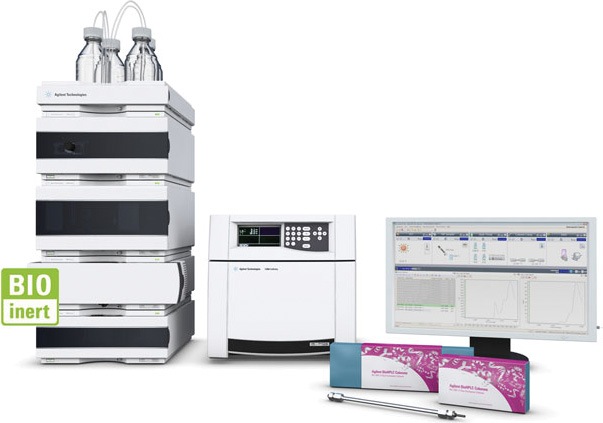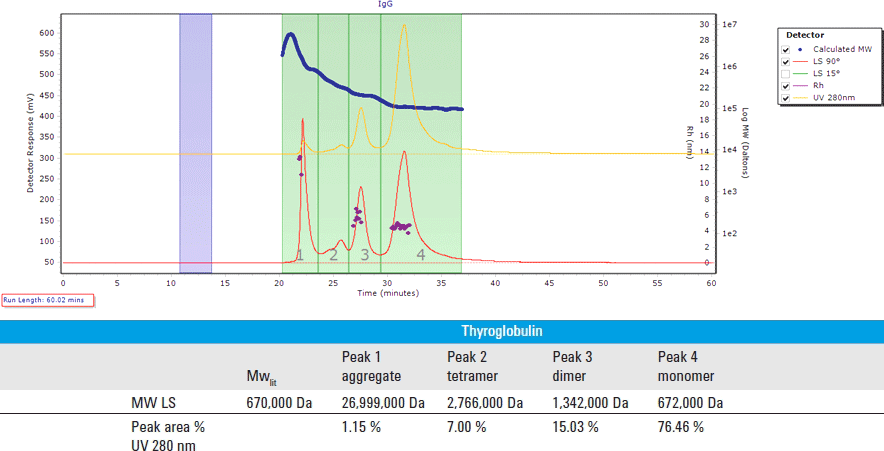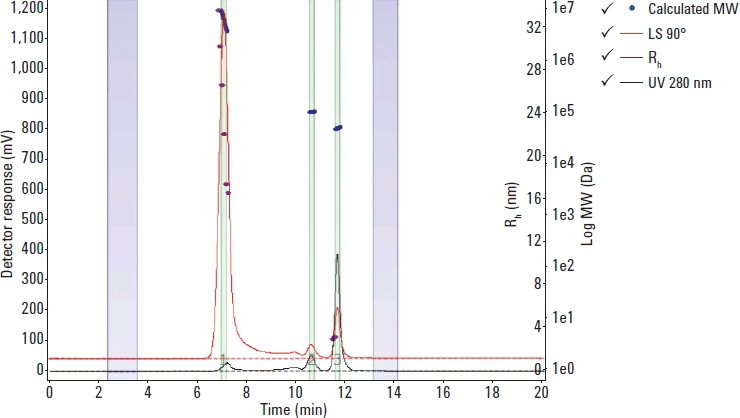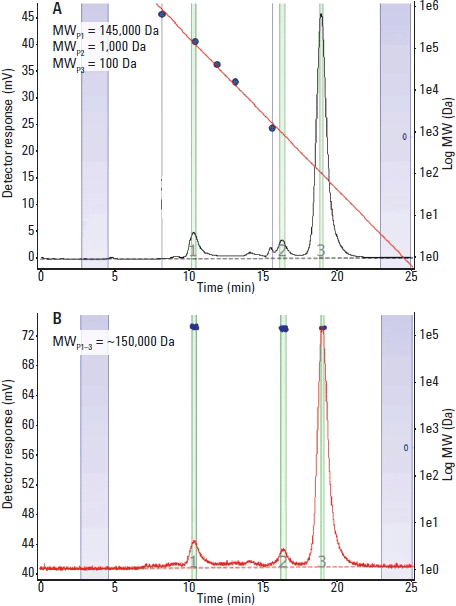Access Agilent eNewsletter, June 2014
>> Update My Profile | Subscribe to Access Agilent | Article Directory

Achieve greater confidence in bioanalysis with Agilent 1260 Infinity Bio-MDS
By Graham Cleaver
Agilent Business Development Manager
and Sonja Schneider
Agilent Application Scientist
 Enlarge
Enlarge
Figure 1. Agilent 1260 Infinity Multi-Detector Bio-SEC solution.
Monoclonal antibodies (MAbs) are a significant development in the battle against cancer. Specific types can trigger the immune system to attack malignant cells, block signals that cause cells to divide, or carry therapeutic drugs to affected cells. Size exclusion chromatography (SEC) is the standard method used to identify and quantify monomers, dimers, aggregates, and excipients that are present in biotherapeutic proteins, peptides and vaccines. SEC is also a common requirement for regulatory approval. The Agilent 1260 Infinity Multi-Detector Bio‑SEC solution (see Figure 1) comprises the Agilent 1260 Infinity bio-inert quaternary LC system and the 1260 Infinity Bio-MDS system which is fully optimized for the reproducible advanced analysis of such protein-based biologics and biosimilars. A complete range of instrumentation, columns, standards and software has been designed for both expert and routine use, making reproducible, accurate analysis easy, whatever your level of expertise with SEC or Gel Filtration Chromatography (GFC).
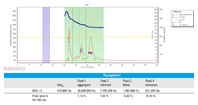 Enlarge
Enlarge
Figure 2. Light scattering detection of thyroglobulin monomer, oligomers and aggregates.
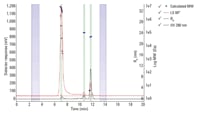 Enlarge
Enlarge
Figure 3. Characterization of ovalbumin, peak 1 is the monomer, 2 the dimmer and 3 the aggregate.
Powerful, easy to use, dedicated Bio-SEC software
Repeatability and reproducibility is key to having confidence in knowing that the same results will be obtained regardless of which instrument in which laboratory is being used. With Agilent Bio-SEC software, baselines and integration regions are quickly and easily defined with a single mouse click. Templates can be set up and stored ensuring excellent repeatability.
Determining molecular weight and size is of particular importance in characterizing biomolecules. The presence of any aggregates can have a significant impact on efficacy and safety. Light scattering detection is a useful tool for monitoring thyroglobulin and its aggregates, as shown in Figure 2. The table shows the molar mass of peak 1 to be ten times greater than that of the tetramer, which confirms that it is indeed an aggregate. The area % is calculated from the UV detector signal and represents the relative concentration of the oligomers and the aggregate.
Easy protein characterization with Agilent 1260 Bio-MDS
The Agilent 1260 Infinity Bio-MDS System adds static light scattering and dynamic light scattering detection to UV or photodiode array, for the ultimate tool in protein characterization. It is possible to determine absolute molecular weight without the need to calibrate the columns. Dynamic light scattering provides information regarding the molecular size and shape in solution. Composition and the presence of even the lowest levels of protein aggregation can easily be monitored (Figure 3). The low volume light scattering flow cell offers maximum sensitivity and guarantees accuracy. The temperature controlled column compartment and detector flow cells deliver excellent baseline stability with minimal equilibration time. For further reading see Agilent Application Note: 5991-3955EN.
Truly bio-inert flow path
During the development and production of pharmaceutical biomolecules, it is essential to monitor the product stability. Even low aggregate levels of pharmaceutically used proteins might lead to negative physiological effects.
During our test analysis, the sample never comes in contact with any metal surfaces. Large biomolecules, especially proteins, are susceptible to unspecific surface interactions, analyte discrimination, and metal ion release, which can cause decreased reproducibility, peak tailing, or lack of resolution. In addition, high salt concentrations commonly employed in SEC can cause corrosion, reduce robustness, and increase instrument downtime. These problems often require special care and tedious passivation procedures, which are no longer necessary through the system’s fully bio-inert flow path, ensuring increased sample throughput and efficiency of any bio-analytical laboratory.
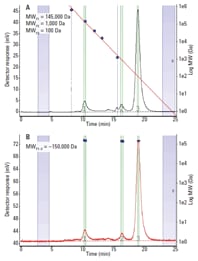 Enlarge
Enlarge
Figure 4. Comparison of traditional SEC analysis column calibration (A) with light scattering analysis at 90° (B).
Advantages of using light scattering detection on monoclonal antibodies
In this example, the characterization of a MAb is illustrated with respect to MW, Rh, and aggregation analysis. The advantage of using LS detection is demonstrated for the analysis of MAb aggregates when compared with using UV detection alone. Reliable determination of MW is achieved independent of the amount of sample injected. When combined with high sensitivity DAD detection, detailed aggregation analysis of the sample becomes possible.
Three peaks are clearly visible in both chromatograms (Figure 4). Using traditional SEC analysis, the first peak has a molecular weight of 145,000 Da, the second and the third peaks have molecular weights of 1,000 Da and 100 Da, respectively. On the contrary, light scattering analysis at 90° reveals a molecular weight of approximately 150,000 for all three visible peaks. All three peaks represent the same antibody, but parts of it elute at different retention times due to unspecific reactions of the antibody with the column. This result is confirmed after DLS analysis of the third peak with an average Rh of 5.23 nm (5.29 nm literature values). According to the column calibration, this molecular size should elute at around ten minutes (where the first peak of the anti-c-Myc antibody is eluting). Consequently, the anti-c-Myc antibody is not eluting as expected because it may be sticking to the column. Other possible explanations for this strange elution behavior could be conformational changes due to denaturation or a different folding process (e.g. non-globular). This example illustrates what a valuable tool the light scattering detector can be for the biochemist. More information on this case study can be found in Agilent Application Note 5991-3954EN.
Agilent offers a full suite of liquid chromatography solutions
Agilent offers biochemists a wide array of liquid chromatography tools and solutions, including the Agilent 1260 Infinity Bio-inert Quaternary LC which sets new standards in performance, reliability and robustness for analysis of bio-molecules. Based on the proven technology of the 1200 Infinity Series liquid chromatography platform, the 1260 Infinity Bio-inert Quaternary LC handles the challenging solvent conditions commonly used for analysis of proteins and bio-therapeutics with ease, as well as minimizing problems commonly associated with these molecules’ non-specific tendencies to bind to surfaces. Take a moment now to view our informative video on Agilent’s liquid chromatography solutions.
>> Update My Profile | Subscribe to Access Agilent | Article Directory
